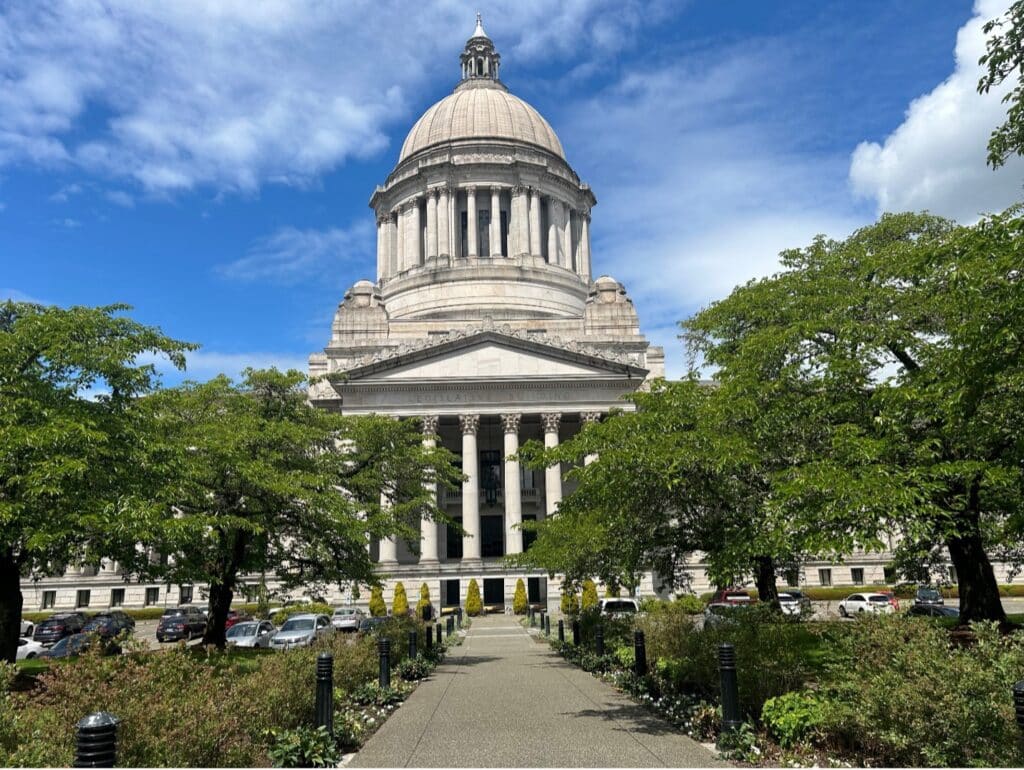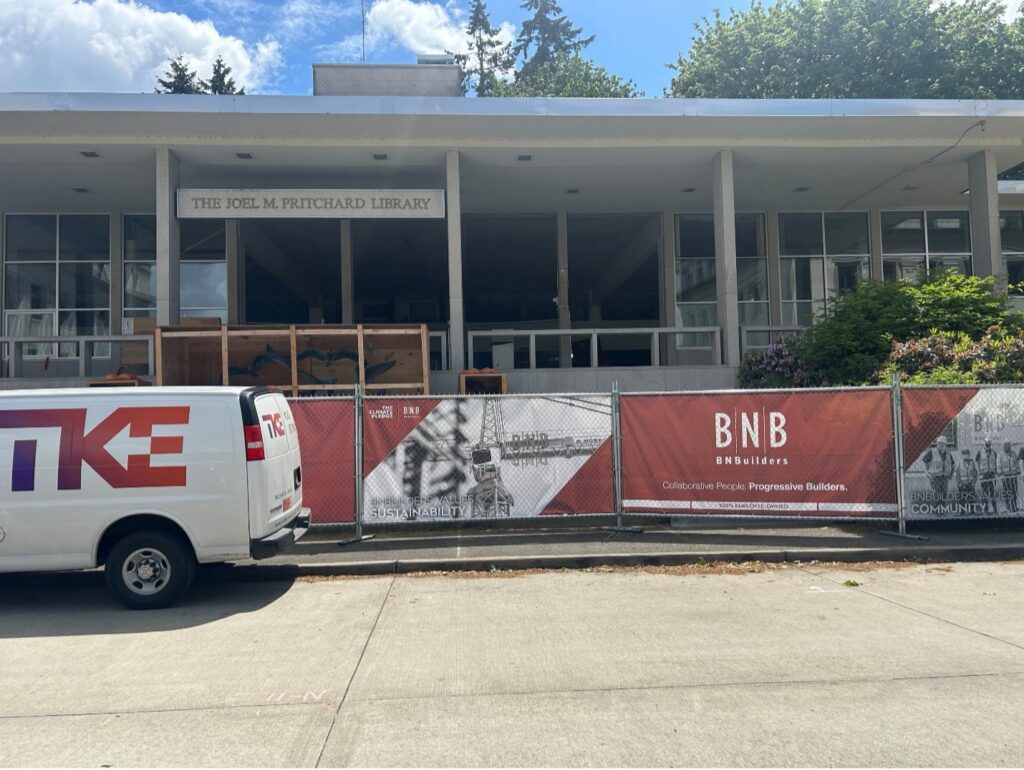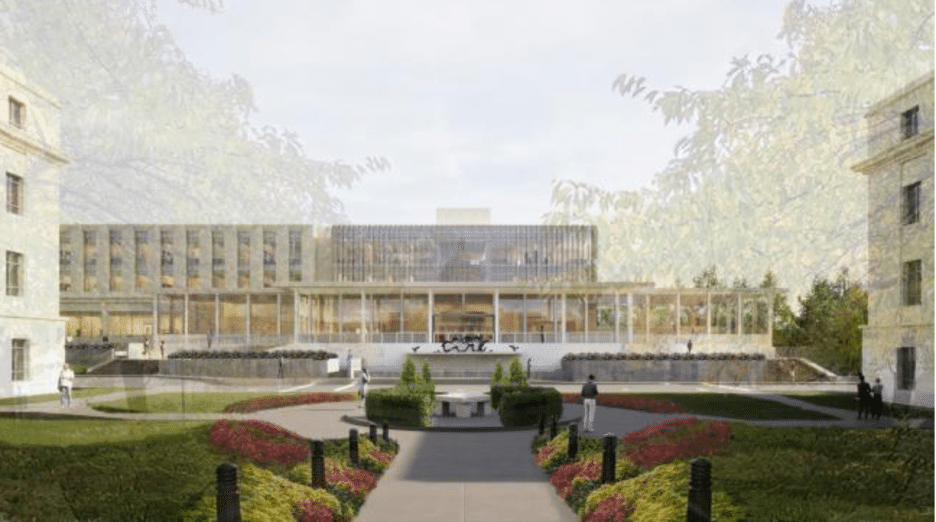 Happy Sunny Interim from the Capitol Building! (Photo Credit: Erica Hallock)
Happy Sunny Interim from the Capitol Building! (Photo Credit: Erica Hallock)
Notes to the Reader: Start Early Washington publishes “Notes from Olympia” intermittently during the legislative interim.
Thanks to those who responded to our survey about this publication. You all provided excellent feedback and suggestions on ways to improve the product. Several folks mentioned incorporating video content, an intriguing idea that may push us out of our comfort zone, but we are game to give it a whirl!
And in case you were waiting with bated breath… 60.6% of the Notes readers who responded favor the Razor Clam for the official Washington State clam. Sorry geoduck fans!
What We Are Watching…
The State’s Revenue Picture
In the past few weeks, several economic indicators have been released that, collectively, signal potential concerns around the state’s fiscal outlook. These include:
- Reduced Capital Gains Revenues – In late May, the Department of Revenue reported a drop in Capital Gains collections for Tax Years 2022 and 2023. (Check out the Washington State Standard article more in-depth coverage).As of May 17, 2024, $433 million in Capital Gains taxes have been collected for Tax Year 2023, significantly less than the $673 million projected in the February revenue forecast. Capital Gains payments are due by April 15th annually, but filers can request an extension. This collection amount could increase with late payments.Further, the Department of Revenue reported that with additional late payments and refunds, actual collections for Tax Year 2022 for Capital Gains were $786 million, not the assumed $896 million.We can expect these updated figures to be factored into the June revenue forecast (discussed below).As a reminder, the first $500 million collected in Capital Gains annually is deposited into the Education Legacy Trust Account. The Education Legacy Trust Account is used to support early learning, common schools (aka K-12 education) and higher education. Any amount collected above $500 million annually is deposited into the Common Schools Construction Account. This means the drop in Tax Year 2022 revenue impacts the amount of funding available for the Commons Schools Construction Account and, if the payments for Tax Year 2023 remain under $500 million, this will impact deposits into the Education Legacy Trust Account and budget writers will have to make necessary adjustments. More to come on this as we learn more.
- Drop in Estimated Reserves in Four-Year Budget Outlook – Washington state law requires the Legislature to adopt a four-year balanced budget that leaves a positive ending fund balance in the general fund and other related funds.On April 25, the Washington state Economic and Revenue Forecast Council adopted its official budget outlook to reflect investments included in the 2024 Supplemental Budget. While the adopted Supplemental Budget balances over four-years, the ending balance for funds subject to the Outlook at the end of the 2025-27 biennium is now $100M. This is $410M lower than the ending balance of $510M included in the estimated Outlook presented to lawmakers alongside the compromise budget in March (aka the conference report).A major reason for this downward adjustment is due to a change in assumptions about “reversions.” Reversions are appropriations that do not end up being spent and “revert” to the state and can then be reappropriated. For reversions, the adopted Outlook assumes 0.8% of appropriations for State Fiscal Year (SFY) 2024, lowering to 0.5% in SFYs 2025-27. In layman’s terms, this means less funding is assumed to “come back” to the state to be invested for other purposes. Specifically, the Outlook assumes $284M of reversions in SFY 2024, $199M in SFY 2025, $189M in SFY 2026 and $194M in SFY 2027.
- Revenue Collections Come in Lower than Forecasted for April 11-May 10 – The state’s Economic and Revenue Council’s May Economic and Revenue Update showed revenue collections for April 11 – May 10 came in $114M (4.6%) lower than forecasted. This report comes after April’s update which showed a $82.9M surplus.Cumulatively, revenue collections are down $60.6M from the forecast (1%).
- Revenue and Caseload Forecasts Out in June – Updated Caseload and Revenue forecasts will be released in June (June 13 and 26, respectively). These forecasts will provide important data points that will inform the state’s budget plans for the 2025-27 and 2027-29 biennia (remember that four-year balanced budget requirement).The caseload forecast will provide a snapshot of expected enrollment in entitlement programs that drive state investments such as K-12, Medicaid and prisons. For early childhood, Working Connections, ECEAP, ESIT and Transition to Kindergarten are all included in the caseload forecast. In short, the caseload forecast provides insight into expected state investments.The revenue forecast will provide an update on anticipated state revenue. These forecasts consider state, national and international factors that impact the economy from construction activity in the Puget Sound to the war in Ukraine. As noted above, we can expect adjustments related to Capital Gains payments.
What’s Coming Up in the 2025-27 Biennium for Early Learning?
State agencies are busy preparing budget requests (or “Decision Packages”) to the Governor’s Office of Financial Management (OFM) to inform Governor Inslee’s final budget that will be released in late December.
Importantly, OFM will be releasing instructions to state agencies sometime in June to guide their budget preparation process. The state’s revenue picture and upcoming change in gubernatorial administration could influence these budget instructions. For example, OFM could direct state agencies to limit budget requests to what expansions or policy changes are included in statute. As a reminder, Governors must release balanced budgets.
These budget requests are due to the Office of Financial Management around mid-September annually.
The Fair Start for Kids Act of 2021 dictated in statute a number of expansions to both Working Connections Child Care and ECEAP during the 2025-27 biennium. As a reminder, these expansions and policy changes include:
- Expanded eligibility for Working Connections Child Care up to 75% of the State Median Income (SMI) as of July 1, 2025. The latest data shows this income equates to $6,386 a month for a family of three.
- Establishment of a $215 a month co-payment for Working Connections Child Care for families between 60% – 75% SMI as of July 1, 2025. This aligns with the expanded eligibility.
- By the 2026-27 school year, any eligible child shall be entitled to enroll in ECEAP.
- DCYF to submit an implementation plan to expand access to the state’s mixed delivery child care system by June 30, 2025. The plan must assume that any financial contribution by families is capped at no more than seven percent of household income and that the child care workforce is provided living wages and benefits. This is also known as the Early Childhood Education (ECE) Access and Living Wage Implementation Plan.
Because these policies are all included in statute, DCYF is preparing to submit Decision Packages to outline expected costs. DCYF will also be considering other funding requests, but we can expect the agency to prioritize these statutorily required items.
It is important to remember that policies embedded in statute signal a legislative commitment to fund a policy. Should the Legislature opt not to fund – or fund a policy at a different amount – than what is included in statute, they must take a direct action to change their previous decision. Conversely, items listed in statute as “subject to appropriation,” can simply not be funded without any further action by the Legislature.
Candidate Filing Week, By the Numbers
The 2024 primary and general elections are shaping up to be some of the most competitive and interesting in recent memory. With open seats from Governor through counties and cities, hundreds of Washingtonians opted to run for public office during the May 6-10 “Candidate Filing Week.” Check out the Secretary of State’s website for an official listing of the offices and candidates.
We thought we would use numbers to convey some themes and stories that jumped out to us from filing week. (Note this is not intended to be all-inclusive).
3: Three people named Bob Fergusons initially filed to run for Governor. Ultimately, two of the “Bob Fergusons” withdrew, leaving the state’s current Attorney General as the only “Bob Ferguson” in the race.
This situation helped us learn about a 1943 law that makes it a felony to run for office against someone with the same name with the goal of confusing the voters. Check out the Washington State Standard’s coverage of the issue.
4: Four incumbent Senators are running unopposed.
19: The number of House members who are running unopposed.
8: The number of current House members who are running for open Senate seats.
6: Candidates filed to run for the open Senate seat in the 4th Legislative District (LD). A total of 5 Republicans (including current House member Rep. Leonard Christian) and one Democrat. The most crowded Senate race.
6 is also the magic number for the open House position 2 seat in the 4th LD. In this race, four Republicans and two Democrats are running. After two candidates withdrew from the House position 1 seat in the 5th LD, this race in the 4th became the most crowded House race.
1: One candidate is running for the open 3rd LD Senate seat currently occupied by departing Senate Majority Leader Andy Billig. Current Representative Marcus Riccelli is running unopposed for this seat after the individual who filed to run against Riccelli withdrew their candidacy.
1: One former House member is running for the House in a different legislative district than he originally served (former Representative Mark Hargrove from the 47th LD filed to run for the House 5th LD Position 1).
16: Sixteen current legislators drew opponents from their same party.
2 of these current legislators are running for the Senate (one Republican and one Democrat).
The remaining 14 legislators are all running for re-election in the House. Of these, 9 are Democrats and 5 are Republicans.
As a reminder, Washington state operates a “top-two” primary system, where the two candidates receiving the most votes advance to the general election. Learn more at the Secretary of State’s webpage.
Washington’s primary election is on August 6, 2024.
Check out Washington’s online voter registration portal!
Our Policy and Advocacy Shop is Hiring!
Our Policy and Advocacy Team is looking to turn our duo into a trio! We’re in search of someone to assist our efforts of bolstering early learning in our great state. If you know anyone who is passionate about Washington State, its families and providers, and is interested in learning about the legislative process, please refer them to our Policy and Advocacy Associate position. In addition, Start Early Washington is hiring a Senior Communications and Development Associate to drive external awareness and engagement with potential supporters and people working in early childhood and related fields. We look forward to reviewing applications!


 The Joel M. Pritchard Library – the latest building on the Capital Campus under construction (Photo Credit: Erica Hallock)
The Joel M. Pritchard Library – the latest building on the Capital Campus under construction (Photo Credit: Erica Hallock)